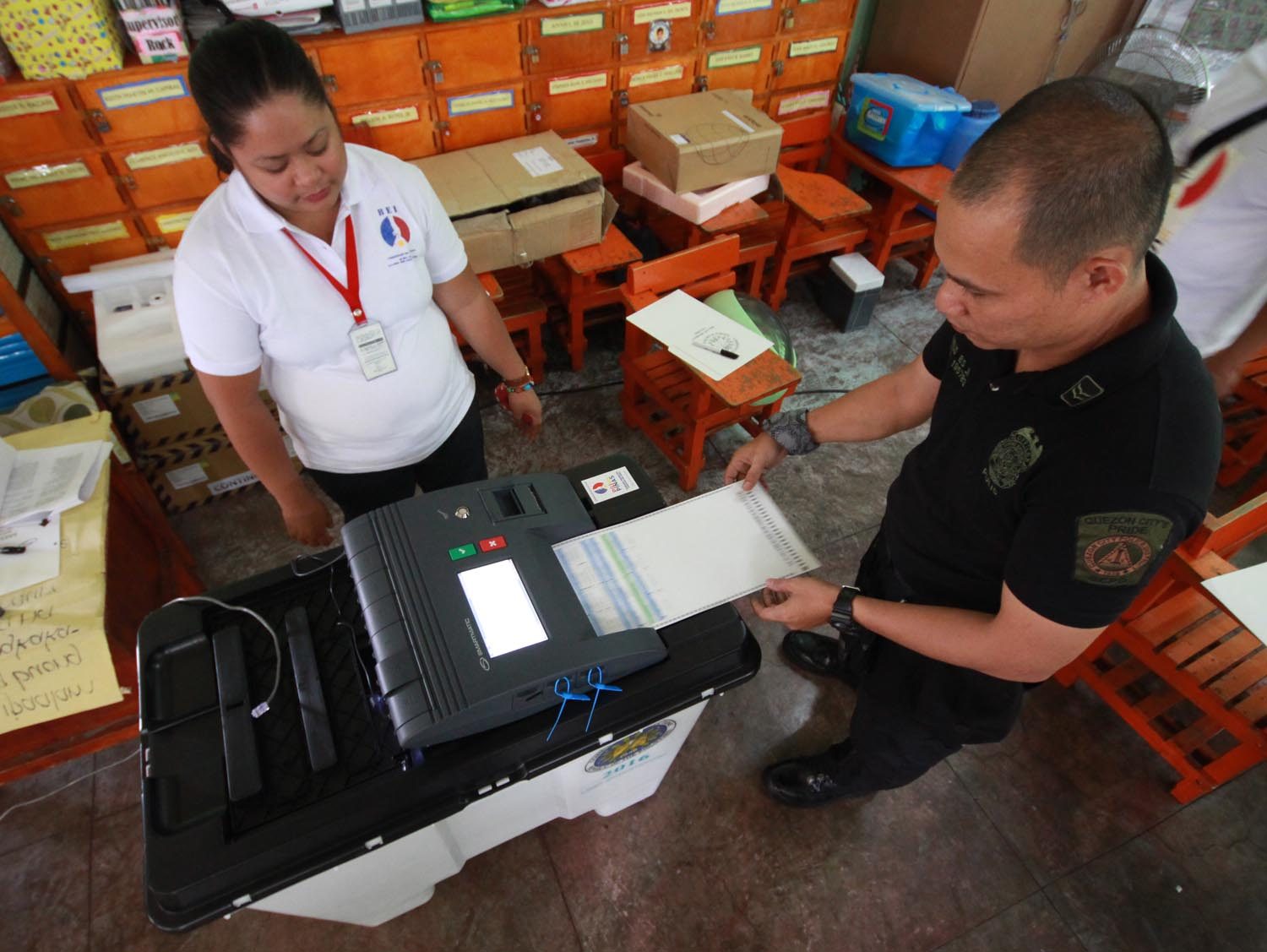SUMMARY
This is AI generated summarization, which may have errors. For context, always refer to the full article.

The work of attorney Emil Marañon III appears to be scholarly, but I am far from being impressed. He holds the view that the physical ballot qualifies as the voter verified paper audit trail or VVPAT required by Republic Act Number 9369. Hence, the voter receipt is a mere redundant feature. (READ: Why it’s alright not to have voting receipts)
I disagree. First, for practical utility, the physical ballots are locked inside the ballot box and out of reach by the voter. His only means to verify that the machine read and counted his choices correctly is when an electoral protest is filed. It is not only expensive and protracted, but requires prima facie evidence first to warrant a recount.
Since evidence from the voting machines and canvassing systems are withheld by the Commission on Elections (Comelec), insurmountable hurdles await any would-be protestant. Thus, the right to have one’s vote correctly read and counted as an indispensable part of the right to vote is effectively denied.
Second, the random manual audit (RMA) using the physical ballot requires that the procedures established to insure the randomness and reliability of the sample is observed. The Carter Center noted that the procedures were disregarded by the Comelec itself. The precincts subject to RMA were prematurely disclosed. Election cheats could easily keep away from those precincts to avoid discovery. Thus, their utility to prove accuracy had been severely curtailed.
Third, the very subject matter of the law is the automated election system or AES. When the law required minimum system capabilities, it is the system which must be verified and not the voter’s own physical ballot. The physical ballot as unprocessed input must first necessarily go through processing by the AES before it can be considered as processed output subject of verification by the voter. The voter receipt, printed after processing by the AES, is clearly the only paper trail with which the voter can readily, timely, and effectively carry out his verification.

Attorney Marañon argues that as an additional safeguard, the VCM is also capable of scanning all ballots fed into it and storing them as an additional paper trail.
I disagree.First, this argument entirely misses the fact that the ballot images are encrypted, not readily readable, stored inside the CF cards, guarded zealously by the Comelec, and examined only in an expensive and protracted electoral protest. Thus, they are of no practical utility to the voter.
Second, the ballot images in the 2013 elections were skewed by the “digital lines” which caused the PCOS to automatically add and subtract votes, thus wreaking havoc on the vote count. Based on the Comelec’s report, up to 6,278,554 ballots could have been affected. Based on evidence from precincts under protest, up to 39,178,177 votes could have been wrongly counted.
Attorney Marañon also argues that the kind of paper audit trail has to depend on whatever technology is chosen by the Comelec, and that voter receipt is applicable only in DRE systems.
I strongly disagree. It is wrong to posit that only a particular kind of paper audit trail can be used for a particular voting technology. Voter receipt as VVPAT equally applies to both OMR and DRE technologies. It is not the exclusive domain of DRE. In fact, Smartmatic’s VCM comes already equipped with the capability of printing voter receipt. This is clear recognition that voter receipt as VVPAT finds suitable application and utility in OMR technology. (READ: Comelec might issue vote receipts to OFWs, but not to local voters)
As the provision is worded in the law, it does not make a distinction between the two main technologies in voting systems. Basic statutory construction says that where the law does not distinguish, so shall we.
Attorney Marañon argues that, even in manual elections, voters have no assurance that their ballots will be counted at the end of the day. Thus, the opportunity to verify in automated elections does not hold water.
This argument is totally misplaced. Elections must be perceived to be transparent to restore voter confidence in electronic voting systems, according to the Indian Supreme Court which ordered the printing of voter receipt or VVPAT. In manual elections, it suffices that the ballots are publicly opened, read, and counted. The very public nature of the counting of the votes sufficiently addresses the issue of transparency and affords a reasonable degree of assurance that the votes are counted at the end of the day.
In stark contrast, in automated elections, the ballots boxes are never opened and the ballots are secretly read and counted inside the machine. The very opaque or hidden nature of automated vote counting negates transparency and foments distrust and suspicion especially where evidence actually exists and is well-documented.
Attorney Marañon parrots the same line of the Comelec to justify its opposition to the voter receipt – vote buying.
I strongly disagree. I proposed that all voter receipts must be deposited into the old yellow ballot box prior to exiting the precinct. The deposited receipts will be subject to manual verification count after the polls close to check against the secretly counted votes reported by the machine. Since no voter receipt will be brought out of the precincts, no vote buying can be facilitated by it.
Finally, Attorney Marañon argues that Smartmatic’s compliance with the minimum system capabilities “has been elevated so many times to the Supreme Court, and each time it is rejected,” citing Roque vs Comelec and Capalla vs Comelec.
I disagree. Of the more than a dozen petitions filed and pending before the Supreme Court, only 4 petitions have so far been finally decided. Of these 4, two are totally unrelated to the issue of compliance. Quite obviously, the remaining two other could hardly be considered as “elevated so many times to the Supreme Court, and each time it is rejected.” Candor is a requirement if one wishes to win others over to his side.
Roque vs Comelec was decided 8 months before the elections. It dealt mainly on technical capabilities and not the actual operation of the machines on election day.
In 2010, the Melo Comelec removed via Resolution 8786 the second iButton containing the digital signatures of the teachers with instructions “not to digitally sign the transmission files.” In 2014, then Chairman Sixto Brillantes Jr publicly admitted that no source code review was ever made in the 2010 elections. In 2015, Chairman Andres Bautista publicly admitted that “nagkulang ang Comelec noong 2010 at 2013” in relation to the security features of the system.
Also, Roque vs Comelec never definitively ruled that the physical ballot and ballot image are the acceptable versions of the VVPAT. It merely cited the various safeguards included in the system design without discussing what constitutes the VVPAT. The Comelec purposely misinterpreted it.
In Capalla vs Comelec, there is no discussion whatsoever about the voter receipt or VVPAT. It was not an issue in the case. At most, there were side statements on the matter of digital signatures, but there was nothing about the VVPAT. Reliance on Capalla is clearly misplaced.
Finally, India’s Supreme Court said: “VVPAT is a system of printing paper trail when the voter casts his vote, in addition to the electronic record of the ballot, for the purpose of verification of his choice of candidatexxx.”Despite the electronic record of the ballot, the court found the necessity, not redundancy, of printing paper trail.
Since it has been admitted by Attorney Marañon that indeed former Senator Richard Gordon is correct in asserting that the VVPAT is mandatory under the law and considering all these arguments and circumstances, it is absolutely wrong to disable the voter receipts. – Rappler.com
Glenn Chong is a former representative of Biliran, a lawyer, certified public accountant, doctor of humanities, honoris causa, and member of the election watchdog AESWatch.
Add a comment
How does this make you feel?
![[In This Economy] Is the Philippines quietly getting richer?](https://www.rappler.com/tachyon/2024/04/20240426-Philippines-quietly-getting-richer.jpg?resize=257%2C257&crop=194px%2C0px%2C720px%2C720px)
![[In This Economy] A counter-rejoinder in the economic charter change debate](https://www.rappler.com/tachyon/2024/04/TL-counter-rejoinder-apr-20-2024.jpg?resize=257%2C257&crop=267px%2C0px%2C720px%2C720px)
![[Vantage Point] Joey Salceda says 8% GDP growth attainable](https://www.rappler.com/tachyon/2024/04/tl-salceda-gdp-growth-04192024.jpg?resize=257%2C257&crop_strategy=attention)
![[ANALYSIS] A new advocacy in race to financial literacy](https://www.rappler.com/tachyon/2024/04/advocacy-race-financial-literacy-April-19-2024.jpg?resize=257%2C257&crop_strategy=attention)

There are no comments yet. Add your comment to start the conversation.